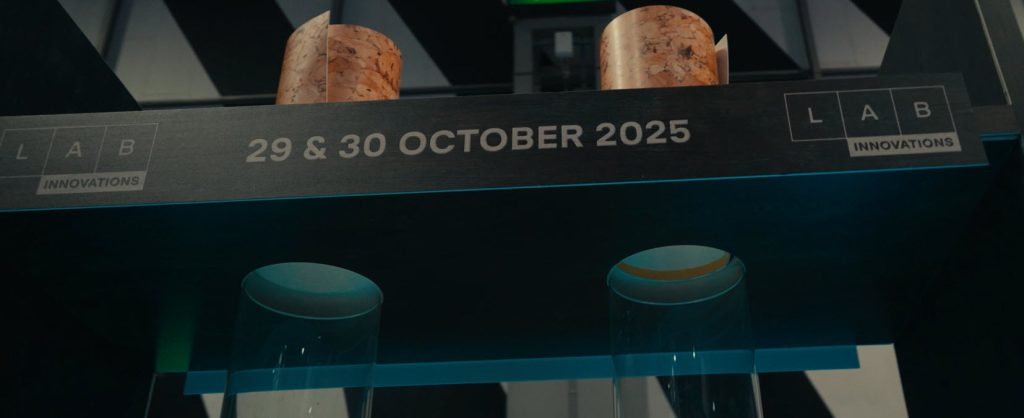Lab Innovations 2025 once again showcased the pace of change sweeping through the laboratory sector. The Lab Innovations 2025 organisers highlighted six key trends shaping laboratory operations, scientific workflows and digital strategy. What was clear across the event is that data, automation and collaboration are becoming the backbone of how modern labs operate. Below is a summary of the top trends seen at this year’s show and what they signal for the future of laboratory environments.
1. AI and automation
One of the strongest trends at this year’s event was the increasing adoption of automation, intelligent workflows and AI-driven decision-making. Exhibitors demonstrated technologies ranging from robotics for sample handling to machine learning applied to diagnostics and large analytical datasets. The key message was clear: the shift from manual to digital operations is accelerating, and labs must prepare for challenges such as system integration, data quality, model validation and user trust.
What this means for your lab:
- Automation requires strong digital foundations, structured data, standardised workflows and connected instruments.
- AI applications depend on consistent, high-quality data, which means labs must focus on improving how data is captured, validated and shared.
- Manual processes will increasingly limit throughput and slow decision-making, making automation a strategic priority rather than a convenience.
2. Biotechnology
Biotechnology continued to dominate discussions this year, with particular emphasis on biobanking, genomics, personalised medicine and biologics development. These areas are expanding rapidly, and with them come greater demands on data processing, integrity and traceability.
What this means for your lab:
- Biotech workflows typically generate large volumes of complex, multi-dimensional and highly regulated data.
- Labs need systems that can reliably track samples, metadata, protocols and analytical results across the entire chain of custody.
- As innovation accelerates, flexible digital infrastructure becomes essential to avoid bottlenecks and support collaboration across disciplines and sites.
3. Sustainability
Sustainability was a major theme across the exhibition floor. The industry is under growing pressure to reduce environmental impact, from lowering single-use plastics to cutting energy and water consumption. Given that laboratories are among the most resource-intensive environments, the shift towards green lab practices is becoming strategic.
What this means for your lab:
- Better data enables better sustainability decisions, for example tracking consumable usage, instrument uptime or freezer capacity.
- Digital systems support more efficient planning and reduce repeat work, waste and unnecessary consumption.
- Sustainability now influences procurement and operational design, meaning future-ready labs must build environmental considerations into their data and equipment planning.
4. Quality and compliance
The event dedicated significant attention to quality infrastructure, with sessions covering accreditation, standardisation, regulatory compliance and supply-chain transparency. As laboratories operate globally and work with increasingly complex materials, quality and traceability issues grow in importance.
What this means for your lab:
- Compliance must be embedded into operational processes, not added after the fact.
- Digital audit trails, version control and secure data handling are becoming essential for demonstrating trustworthiness and meeting regulatory expectations.
- Labs relying on manual documentation or disconnected systems may struggle to maintain compliance efficiently.
5. Skills and workforce evolution
The workforce trend continued to be one of the most discussed topics. With increasing automation, data-driven workflows and advanced instrumentation, labs need staff capable of working across disciplines. The show’s organisers and exhibitors emphasised the importance of cross-functional teamwork, blending scientific, digital, operational and engineering skills.
What this means for your lab:
- Upskilling will be essential, from data literacy to understanding automated workflows.
- As systems become more connected, collaboration between scientists, technicians, IT teams and quality specialists becomes more important.
- Technology modernisation must be matched with investment in people, processes and communication.
6. Cross-disciplinary collaboration
Beyond the formal programme, the general tone of the event highlighted the need for laboratories to break down silos between research and industry, between science and engineering, and between instrumentation and data teams. Dedicated networking spaces were designed to encourage these connections.
What this means for your lab:
- Cross-functional teams lead to better workflow design and reduced bottlenecks.
- Shared data systems and integrated processes help teams collaborate effectively.
- Success in modern laboratories increasingly depends on how well departments coordinate, not just how well they operate individually.
Conclusions from Lab Innovations 2025 key trends
The key trends highlighted at Lab Innovations 2025, made it clear that modern laboratories are entering a new era, one defined by digital foundations, cross-disciplinary cooperation and strategic automation. Understanding these key trends provides valuable insights into the future of labs. Whether your focus is improving efficiency, enhancing data integrity, meeting regulatory obligations or future-proofing your workflows, the direction of travel is unmistakable.
As these trends continue to shape the laboratory landscape, the ability to process data effectively, automate routine tasks and maintain robust quality systems will be essential. This is where Interactive Software can support your progression. Through our work in data management, workflow design and digital transformation, including the capabilities of Achiever LIMS, we help laboratories strengthen their digital foundations, improve data integrity, streamline processes and enable cross-functional collaboration. Whether you are modernising existing workflows, preparing for greater automation or working towards higher standards of compliance and sustainability, our flexible, future-ready, scalable solutions provide the structure needed to adapt with confidence.
